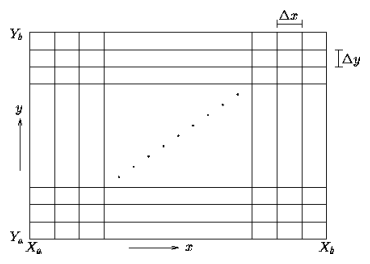
Vortex Evolution with a
Finite Difference Method
The evolution of a two-dimensional (2D) vorticity distribution
is described by the 2D Navier-Stokes equation in the
vorticity-streamfunction formulation.
One of the possible methods to solve this so-called
vorticity equation is a Finite Difference Method,
which applies discretisation of the vorticity equation
on a grid in a finite domain.
Such a method is relatively easy to program and can handle a great
variety of initial vorticity distributions,
ranging from single vortices (e.g. monopole, dipole)
to a vorticity field covering the whole domain (e.g. uniform, random).
The density of the grid and the time step determine the accuracy
of the computation.
The program is named nsevol; you see its logo at the top of this page.
Since it uses the Navier-Stokes equation
to compute the evolution of a certain vorticity distribution,
the program's name is to be pronounced as 'en-es-evol'.

A rectangular domain is discretided in the x and y direction, respectively;
the grid cells do not need to be square.
The value of the vorticity is then computed on each grid point
as a function of time, using a finite time step.
In practice the number of grid cells in either direction is 2n.
Boundary conditions apply simultaneously to opposite boundaries.
- The Finite Difference Method includes
non-linear and viscous effects:
- Non-linear effects describe the change of vorticity due to the
flow field of the vorticity itself, which either increase or decrease the
velocities.
- Viscosity diffuses the vorticity: it is spread over a larger area
and its extrema are reduced, resulting in lower velocities.
-
Background rotation,
an external flow and/or a
bottom topography
can be included as well.
The method also gives the possibility to follow the motion of
passive tracers, like is done in experiments with particles or
blobs of dye. Positioning tracers in the program can be done in a variety
of ways: in a blob, as separate particle and/or as a contour line.
The non-linear term is programmed such that energy, enstrophy and
skew-symmetry are conserved for the case of zero viscosity.
The time integration scheme used (see below) makes the Finite Difference
Method very stable: as long as the velocities on the grid are not too large,
i.e. as long as the time step is not too big, there are no
difficulties.
In practice, the Courant number CFL -- a measure for the maximum
velocity somewhere on the grid -- must be smaller than the square root of 3
in the case when there is no viscosity; if viscosity is present, then
CFL can be somewhat larger.
(In the inviscid case it is even possible to compute backwards
in time using a negative time step.)
-
The following boundary conditions can be applied:
- stress-free
fluid cannot go through the boundary, but it can move along
the boundary without friction.
- "membrane"
fluid can move freely through the boundary, but it cannot move along
the boundary.
- periodicity
fluid that leaves the domain on one side, re-enters the domain on the
opposite side.
- no-slip
fluid cannot go through the boundary and it cannot move along
the boundary either due to friction, i.e. the velocity
is equal to zero at the boundary.
-
Notes:
- --
Boundary conditions 2 is not really relevant for the study of vortex
dynamics for which the program is intended.
- --
Condition 3 is (unfortunately) not available when there is a bottom
topography.
-
There are pages available with:
- - a list of
- - some information on
running the program 'nsevol'.
The numerical scheme
The time evolution of the vorticity equation is computed with an
explicit third-order Runge-Kutta scheme, where viscous term is
discretised with a Crank-Nicolson scheme and the nonlinear term
with the Arakawa scheme.
The streamfunction is found from the vorticity by solving the Poisson
equation with a Fourier Analysis and Cyclic Reduction (FACR) routine if
there is no bottom topography.
If there is a bottom topography a 'modified Poisson equation' must
be solved, which cannot be done by FACR. For that purpose, a NAG routine
using a multigrid method is applied. (The latter routine is unfortunately
a factor of about 10 slower than FACR.)
In either case, the routine solving the streamfunction limits the choice
in the number of grid cells to 2n in either direction.
The basis of this numerical scheme follows from a code developed by
Paulo Orlandi and Roberto Verzicco (Rome, Italy). The routines solving
the streamfunction are added during my work in Eindhoven and Dundee.
Also added is: a great number of initial vorticity distributions, passive
tracers, background rotation, bottom topography, and output of several extra
characteristics of the flow.
To analyse the results, several additional programs are available.
<=== Numerical simulations of 2D vortex
evolution with a Finite Difference Method.
 Jos van Geffen --
Home |
Site Map |
Contact Me
Jos van Geffen --
Home |
Site Map |
Contact Me
created: 1 December 1995
last modified: 26 May 2001



 Jos van Geffen --
Home |
Site Map |
Contact Me
Jos van Geffen --
Home |
Site Map |
Contact Me